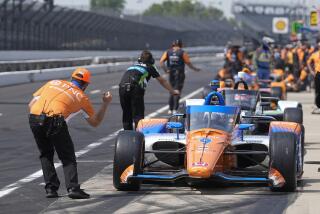INDIANAPOLIS 500 UPDATE : It’s Expensive Where the Rubber Meets the Road
If you are concerned about the price of new tires, consider: A front tire for an Indy car--10 inches wide and weighing 18 pounds--costs $250. One for the rear--14 inches and 23 pounds--lists at $351.
The catch is that their life expectancy is no more than 100 to 240 miles. The racing surface is only 3/32nd of an inch deep, and a variance the thickness of a post card will affect the car’s handling.
Cold tires caused problems at the start of last year’s race, as they often do after pit stops, but once they warm up, they really warm up.
“Going through 90-degree corners at 218 m.p.h. generates so much heat, the tires actually cool down when they are running 238 down the straightaways,” said Leo Mehl, Goodyear’s director of racing.
“If you took the highest quality passenger car tire--ones used on a Corvette--and ran them at Indy, they would not make it through two corners before tread would start coming off.”
Goodyear brought 4,000 tires to Indy. Most of the race tires will be only 20% worn when discarded.
*
A morning-long rain kept practice to a minimum Tuesday, but the cool afternoon led to high speeds. Fifteen cars ran, and Teo Fabi’s was fastest, at 223.381 m.p.h. It was the first time the track had been wet since the opening day of practice, May 8.
More to Read
Go beyond the scoreboard
Get the latest on L.A.'s teams in the daily Sports Report newsletter.
You may occasionally receive promotional content from the Los Angeles Times.










